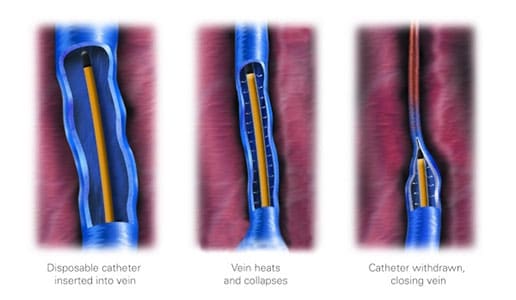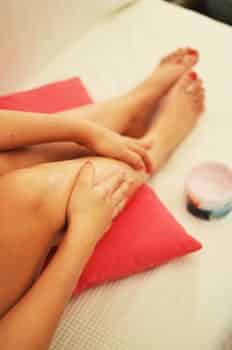RadioFrequency Ablation: How it works
Perhaps the most important thing to know about Radiofrequency Vein Ablation, is that it has a high success rate in treatment of varicose veins. Additionally, it is minimally invasive, minimally painful, has low rates of complication, can be performed in-office, and has a very rapid recovery time, usually about a day.
The Venous Ablation Process
 Introduced in 1999, radiofrequency vein ablation has helped to further revolutionize the management of superficial venous reflux disease, or Chronic Venous Insufficiency, and varicose veins. Using ultrasound to guide them, a vein specialists charged catheter delivers 350-500KHz of radio energy along the path of damaged veins. The affected veins close and are resorbed by the body, and blood flow is rerouted through healthy veins. Prior to operating the RF device, the adjacent tissues are surrounded by a tumescent solution, protecting the area and preventing the patient from feeling discomfort from the heat energy.
Introduced in 1999, radiofrequency vein ablation has helped to further revolutionize the management of superficial venous reflux disease, or Chronic Venous Insufficiency, and varicose veins. Using ultrasound to guide them, a vein specialists charged catheter delivers 350-500KHz of radio energy along the path of damaged veins. The affected veins close and are resorbed by the body, and blood flow is rerouted through healthy veins. Prior to operating the RF device, the adjacent tissues are surrounded by a tumescent solution, protecting the area and preventing the patient from feeling discomfort from the heat energy.
The procedure is very effective in the treatment of large vein varicosities including; the great saphenous vein, small saphenous vein, and perforator veins which link the superficial venous system to the deeper veins.
Learn More about RadioFrequency Vein Ablation
When performed by an experienced, qualified Vein Specialist, success rates for radiofrequency ablation exceed 97%. To see whether you can benefit from this advanced varicose vein treatment, book a consultation and exam with a qualified vein specialist.
References:
https://www.ncbi.nlm.nih.gov/pmc/articles/PMC3377553/: retrieved October 15, 2016
Q & A Pregunta: ¿Qué es el tiempo de induración? Respuesta: el downtime se basa en gran medida en el tipo de intervención y la severidad de la enfermedad venosa. Independientemente del tipo de intervención, nuestros pacientes reanudan todas las actividades el mismo día que el tratamiento. Algunos tratamientos requieren medias de compresión post-procedimiento, pero…
Read MoreQ & A Question: What is the down time? Answer: Downtime is largely based on the type of intervention and severity of the vein disease. Regardless of the type of intervention, our patients resume all activities the same day as treatment. Some treatments require compression stockings post-procedure, but most times these are worn for comfort and…
Read MoreVenas dolorosas y antiestéticas de las piernas Con el calor de Arizona, un día de verano, día de invierno, o cualquier día es ideal para usar shorts. Pero para aquellos con varices o venas de araña, la idea de usar pantalones cortos es preocupante y lleva a la ansiedad severa. Según el Departamento de salud…
Read MorePainful and unsightly leg veins With the Arizona heat, a summer day, winter day, or any day is ideal for wearing shorts. But for those with varicose veins or spider veins, the thought of wearing shorts is troubling and leads to severe anxiety. According to the U.S. Department of Health and Human Services, 55% of…
Read MorePregunta: ¿dos ultrasonidos Doppler encuentran cualquier coágulo de pierna? (Muslo o pantorrilla). ¿Es el síndrome de mayo-Thurner (MTS) posible y un venography necesario en mi caso?
Read MoreQuestion: Would two Doppler ultrasounds find any leg clots? (Thigh or calf). Is May-Thurner syndrome (MTS) possible and a venography necessary in my case?
Read MoreSi quisiera deshacerse de las venas antiestéticas, las venas de araña, o las varices dolorosas; a continuación, la búsqueda de resultados de escleroterapia, a través de un especialista en la vena, puede ser la elección correcta para ayudar a mejorar su dolor, la felicidad y su apariencia. En este procedimiento rutinario, el médico de la…
Read MoreIf would like to get rid of unsightly veins, spider veins, or painful varicose veins; then pursuing sclerotherapy results, through a vein specialist, may be the right choice to help improve your pain, happiness, and your look. In this routine procedure, your vein doctor injects a chemical into the veins which will cause the veins…
Read MoreParece concebible que cuando los expertos en Salud estiman que el 10 por ciento de las mujeres embarazadas experimentan várices vulvares, es decir, varices vaginales, podrían subestimar groseramente la incidencia de esta afección. Hay mujeres — que saben cuántas — que no reportarán este dolor, picazón, pesadez e incomodidad general en la vulva, ya sea…
Read MoreIt seems conceivable that when health experts estimate that 10 percent of pregnant women experience vulvar varicosities, that is to say vaginal varicose veins, they could be grossly underestimating the incidence of this condition. There are women—who knows how many—who will not report this pain, itch, heaviness and general discomfort in the vulva, either because…
Read More


